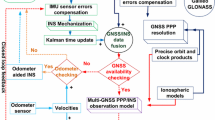Abstract
Present day inertial surveys are limited to single traverse runs in which the number of unknown system parameters to be determined are few, depending on the number of control points available along the traverse. Further, conventional inertial surveys are generally restricted to the determination of coordinates with no possibility for a rigorous post-mission adjustment of the observations. The consequence is the continued presence of systematic trends in the residuals, even after the use of error models such as those proposed by Ball, Gregerson or Kouba. Future work aiming at higher accuracies obviously requires more comprehensive models and rigorous adjustment procedures. These can be accomplished by the development of such error models and by the use of “area surveys”, instead of the single traverses, together with rigorous adjustment procedures suitable for the network of criss-crossing lines inertially surveyed. In such a network the cross-over points serve as constraints for the geodetic parameters (latitude, longitude, height, gravity anomaly, deflection components) and allow the addition of hardware and software related error parameters. Thus an opportunity is provided to effectively self-calibrate the system—a concept successfully used, for example, in photogrammetry or in satellite tracking. The number and the strength of such parameters depend on the number of control and cross-over points. The adjustment, of course, also provides the necessary statistical information on the adjusted parameters, such as their precision and the correlation between them.
The presentation will describe current work at OSU in this area.
Similar content being viewed by others
References
AGARD (1978):Strapdown Inertial Systems. AGARD Lecture Series No. 95, available NTIS, Springfield, Va.
G. BABBAGE (1977):Operation of the Inertial Survey System: The Manager’s View. Proc. 1st Int. Symp. on Inertial Technology for Surveying & Geodesy, pp. 312–321. Canadian Inst. of Surveying, Ottawa.
W.E. BALL, Jr. (1978):Adjustment of Inertial Survey System Errors. Proc. Ameri-Congress on Surveying & Mapping. Washington, D.C., Feb.–Mar., pp. 198–223.
R.J. CARRIERE, J. KOUBA and R.C. PENNEY (1977):Experience with the Inertial Survey System at the Geodetic Survey of Canada. Proc. 1st Int. Symp. on Inertial Technology for Surveying & Geodesy, pp. 146–161, Canadian Inst. of Surveying, Ottawa.
S.R. ELLMS (1977):A Description of the Auto-Surveyor System and Its Sub-System Accuracies. Proc. 1st Int. Symp. on Inertial Technology for Surveying & Geodesy, pp. 78–89, Canadian Inst. of Surveying, Ottawa.
H.C. HARRIS (1977):DMA Operations with an Inertial Positioning System. Proc. 1st Int. Symp. on Inertial Technology for Surveying & Geodesy, pp. 138–145, Canadian Inst. of Surveying, Ottawa.
J.R. HUDDLE and R.W. MAUGHMER (1972):The Application of Error Control Techniques in the Design of an Advanced Augmented Inertial Surveying System. Proc. 28th Annual Meeting of the Inst. of Navigation, West Point, N.Y.
J.R. HUDDLE (1976):Navigation to Surveying Accuracy with an Inertial System. Proc. Bicentennial National Aerospace Symp., Warminster, Pennsylvania.
J. KOUBA (1977):Geodetic Adjustment of Inertial Surveys. Proc. 1st Int. Symp. on Inertial Technology for Surveying & Geodesy, pp. 162–187, Canadian Inst. of Surveying, Ottawa.
R.H. LENTZ and R.J. BUCHLER (1975).Inertial Positioning System (IPS). The Final Procedure and Software Programs Used to Perform Smoothing of the IPS Mission Output Data on the IBM-7094. Litton Guidance & Control Systems. Woodland Hills, California.
G.R. MACOMBER and M. FERNANDEZ (1962):Inertial Guidance Engineering. Prentice-Hall Inc., Englewood Cliffs, New Jersey.
K.P. SCHWARZ (1978):Accuracy of Vertical Deflection Determination by Present-Day Inertial Instrumentation. Proc. 9th GEOP Conference, Applications of Geodesy to Geodynamics, I.I. Mueller, ed., Dept. of Geodetic Science Rep. 280, Onio State Univ., Columbus.
K.P. SCHWARZ (1980):Inertial Survey Systems-Experience and Prognosis. Canadian Surveyor, Vol. 34, No. 1, pp. 41–53.
K.P. SCHWARZ (1981):Error Characteristics of Inertial Survey Systems. FIG XVI Int. Congress, Paper No. 511.1, Montreux, Switzerland.
M.S. TODD (1977):The Development of the Inertial Rapid Geodetic Survey System at USAETL. Proc. 1st Int. Symp. on Inertial Technology for Surveying & Geodesy, pp. 113–120, Canadian Inst. of Surveying, Ottawa.
M.S. TODD (1979):New Experiments and Results in Inertial Surveying at the U.S. Army Engineer Topographic Laboratories. Proc. American Congress on Surveying & Mapping, 39th Annual Mtg., Washington, D.C.
U.A. UOTILA (1967):Introduction to Adjustment Computations with Matrices. Lecture notes, Dept. of Geodetic Science, Ohio State Univ., Columbus.
U.A. UOTILA (1973):Sequential Solutions with Observation Equations. Lecture notes, Dept. of Geodetic Science, Ohio State Univ., Columbus.
Author information
Authors and Affiliations
Rights and permissions
About this article
Cite this article
Hannah, J., Mueller, I.I. Improvement of inertial surveys through post-mission network adjustment and self-calibration. Bull. Geodesique 55, 329–339 (1981). https://doi.org/10.1007/BF02527056
Received:
Accepted:
Published:
Issue Date:
DOI: https://doi.org/10.1007/BF02527056




